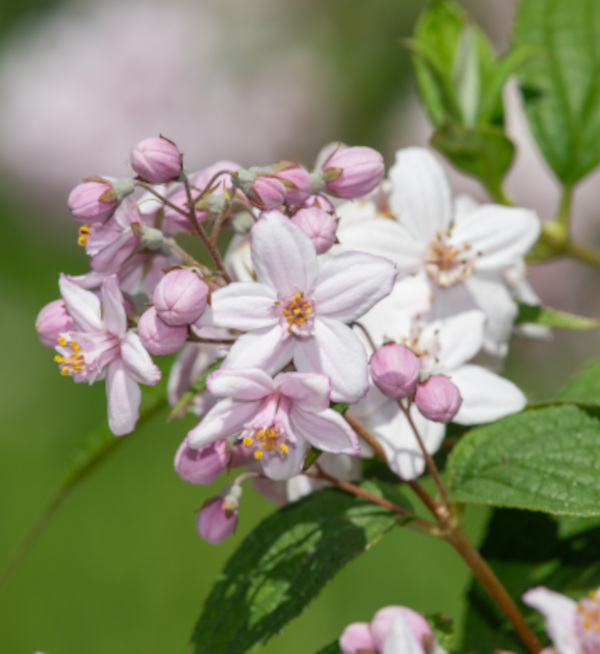How to grow Deutzia
Deutzia are within the Hydrangeaceae family and are a large group of approximately 60 wild species native to eastern and central Asia.
Most are deciduous but a few subtropical species are evergreen. Deutzia range in height depending on species from 60cm to 3m. Mature specimens have flaking bark which is used by nesting birds. Leaves grow along the stem as opposite pairs. Clusters of star shaped, sometimes fragrant flowers are borne in summer as single or doubles in pink or white dependant upon variety. Flowers are often corymb shaped where lower stalks of the cluster are longer so that all the flowers are at the same level forming a flat head. All deutzia have hollow stems.
The genus was named by Carl Peter Thunberg for his friend and patron Johann van der Deutz an 18th century botanist.
Individual species may have their own common name, as you’ll see from our table below.
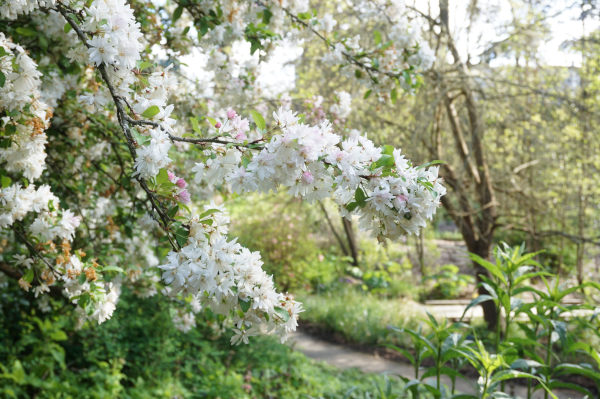
Zantedeschia is a genus of flowering plants from the family Araceae and is native to southern Africa. With a rich history dating back to the Ancient Romans, these deciduous or semi-evergreen perennials have been used as a symbol of celebration. Zantedeschia was Named after Professor Giovanni Zantedeschia, an Italian botanist.
There are two main forms of Zantedeschia: hardy and tender. Hardy forms of the plant can be grown outdoors, enjoy moist soil and full sun or partially shaded conditions - these are known as Arum lilies. Tender forms of Zantedeschia prefer being grown in containers or pots and should be brought inside over the winter - these are known as Calla lilies.
With tuberous flora in all colours from whites, yellows and oranges to deep reds and purples, Zantedeschias are not to be overlooked in any garden, as long as they have sufficient sunlight to grow in.
Ready to learn more about growing Zantedeschia? Read on for all there is to know...

Key Information
Soil pH
Position
Hardiness

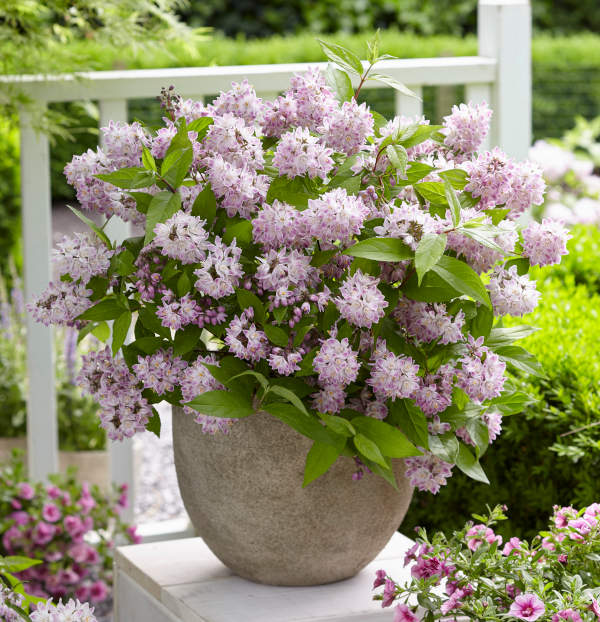
| Species | Common name |
HARDY – cold winter (H5/ -10°C to -15°C) Grow anywhere in the UK | Deutzia crenata | Crenate deutzia |
Deutzia gracilis | Japanese Snow Flower | |
Deutzia scabra | Fuzzy deutzia | |
Deutzia setchuenensis | Corymbose deutzia | |
Deutzia x elegantissima | ||
Deutzia x hybrida |
Where & when to plant Deutzia
Position - Sun or Part Shade
Soil - Moist free drained humus-rich soil, acid – neutral – alkaline
Flower - Summer
Deutzia can be planted all year around when purchased grown in pots. Bare rooted plants are best planted in late winter or early spring when the ground is not frozen or waterlogged.
If container grown plants are planted out during the active summer growing season make sure that they are watered regularly until the plant has settled into its new location. Water at soil level rather than the foliage.
Larger growing plants can be planted in the garden as a specimen whilst there are more compact varieties which can be planted in mixed borders or patio containers. Most deutzia prefer a little shelter from late spring frosts which can cause tip dieback that effects flowering.
Deutzia prefer a little shelter from afternoon sun in hotter areas so best not to plant against a south facing wall in full sun without shade from other established plants.
Plant in moist yet free draining soil that has a pH of 6 – 8. Deutzia will grow in all soil types, chalk, clay loam and sand.
How to plant Deutzia
- For planting in the garden, dig the soil area removing any large stones and weeds and breaking up any lumps. Mix in some organic matter, ideally leaf mould, though manure or garden compost are also fine. Rake level and firm with your heels. Rake level again.
- Water plants well and allow to drain before planting.
- A good tip is to dig a hole twice the size of the root-ball. Fill with water and allow to drain before placing in the plant which is especially good for summer plantings.
- Remove the plant from its pot placing the plant in the hole, ensuring the top of the root ball sits level with the surface of the soil. Too low and the plant may rot, too high and the roots can dry out. If bare root hold the plant at soil surface level allowing roots to dangle into the hole.
- Backfill with soil and firm in gently with your foot.
- Soak soil well with water.
- Mulch around the base with well-rotted organic matter.
- For planting in containers, first choose an appropriately sized pot around 5-7cm larger than the rootball of your plant (you’ll need to gradually increase the pot size every few years). Always ensure there are plenty of drainage holes in the bottom.
- Use a good quality potting compost if you have it and mix with garden soil. Mix in some horticultural grit and, if not already present (check the labelling on the bag) some slow-release fertiliser granules.
- Start by partially filling the pot with compost; enough so that when placed on it the upper surface of the root ball is about 3cm lower than the top of the pot.
- Fill around the plant with compost, firming down with your fingers then adding a little more so it is held tight.
- Pick up the container and lightly tap on the potting bench or ground a few times to help further settle the compost around the plant.
- Soak well with water.
- A mulch with horticultural grit will look attractive and help to prevent a ‘cap’ or crust forming on the top of the compost (something container plants can suffer due to the artificial nature of their watering).
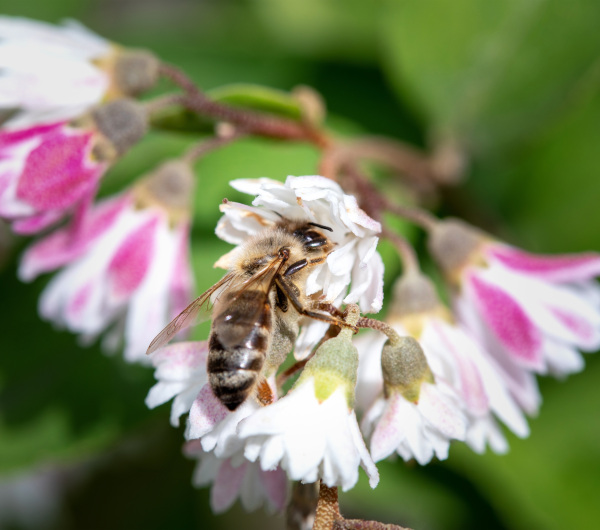
What to plant with Deutzia
Outdoors, plant alongside plants with different shaped or coloured foliage as a contrast. Try Ferns, Roses, lavender, Hebe, Philadelphus, Lilac (Syringa), Petunia, Tulip, Narcissus (Daffodil) and hardy Geraniums.


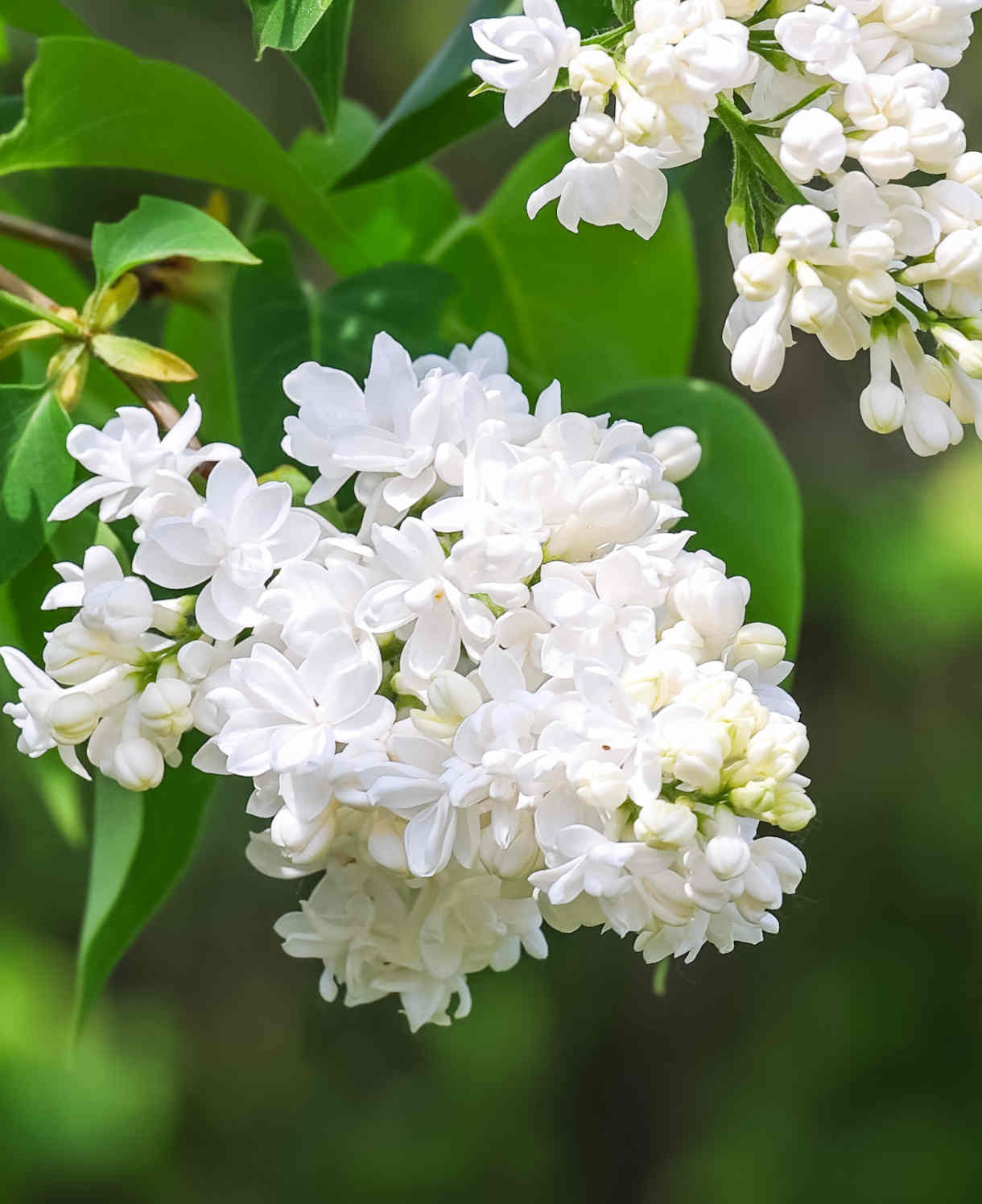
How to care for Deutzia
Pruning and Deadheading
Deutzia are easy care garden plants falling into RHS pruning Group 2. Prune immediately after flowering has finished.
Deutzia flower on previous season growth, so by pruning straight after flowering the plant has time to develop new shoots this year for flowering next summer.
- Cut back flowered growth to strong young shoots lower down. Each year cut out up to 20 percent of ageing stems to near the base. Cut out any damaged or dead shoots back to their point of origin or to ground level.
- Where there are many stems remove some to ground level to keep the bush open and avoid congestion.
- Finally take out any weak, spindly or twiggy shoots right to the point of origin or to ground level so the plant concentrates its resources on strong new shoots that will bear the best flowers next summer.
Watering
Deutzia enjoy moist yet free rained soil. On planting outside, they benefit from a good watering in on planting and then regular soakings until established. After this they should need watering only in very hot, dry conditions. Allowing the top few centimetres to dry out between soakings is a good rule of thumb to avoid overwatering. To check this, wiggle your finger down into the soil until you hit a cool, damp bit.
Feeding
On healthy, fertile soil, a mulch of well-rotted organic matter (i.e., a layer of leaf mould, manure, or garden compost applied to the soil around the plant) should provide enough nutrients for your deutzia. This has the added benefit of suppressing weeds and locking in moisture. Mulch when planting, and then again each spring.
If you garden on poor soil or your deutzia looks in need of a boost, applying a granular general purpose feed to the surface of the soil and lightly working in can reap benefits. This is known as a top dress and should be done when you’re mulching in spring – first apply the feed, then cover with the mulch.
Container-grown plants are different as they rely solely on the gardener for nutrition. Get off to a flying start by making sure you use a good quality compost with slow-release granules mixed in. These generally provide nutrients for around 6 to 8 weeks, after which you’ll need to apply a liquid feed every 2-3 weeks until the end of the growing season (i.e., September-ish).
Remember to repot your deutzia every few years into a slightly larger pot using fresh compost. In-between, it’s worth removing the top few centimetres of compost each spring and replacing with a fresh mix of compost and slow-release granules.
Cold Protection
Deutzia are rated Hardy by the R.H.S - H5 can be relied upon to get through a UK winter without concern. Protect container-grown specimens in very severe cold, exposed areas. Bring under shelter of the overhang of a roof and make sure water can freely drain from the bottom of its container. Otherwise, leave them to it!
Pests and Diseases
Deutzia are generally considered problem-free, yet on rare occasions can suffer from honey fungus. This is a common disease which effects the base of the plant where visible signs of white mould can be seen.
Treatment can be found here.
How to propagate Deutzia
The recommended way to propagate deutzia is by softwood cuttings.
- In late spring to early summer collect some branches containing tender new season growth early in the day..
- Choose a non flowering tender young shoot which is approximately 5-10cm long from its tip.
- Using a sharp knife trim below a node (leaf joint) Remove the lower sets of leaves leaving 2 to 4 leaves at the top.
- Pinch out the soft tip to just above a leaf joint and dip the base into rooting hormone powder or liquid.
- In a ready watered and drained pot level filled and lightly firmed with good quality new compost, make a hole for the cutting with a dibber. Insert the base of the cutting until the first set of leaves are just above the surface.
- In a 9cm pot you can put 3 cuttings in a triangular formation making sure the leaves are well within the edges of the pot.
- Cover with a plastic sandwich- like-bag to form a mini propagator is a good idea for the first few weeks. Hold the bag in place on the pot with an elastic band or string. Ensure the bag is stiff enough to hold upright above the plants foliage. The plastic bag holds in moisture keeping the humidity high which reduces the rate of water loss from the cutting, increasing the success rate of propagation.
- Place the pot on a saucer away from direct sunlight, yet in a light area that is around 18-24o
- At least twice a week remove the bag to allow some ventilation to the cuttings for 15 minutes. Check the soil surface feels damp.
- Rooting takes 2 to 4 weeks. Gently pull on one of the cuttings if it shows resistance then it is likely roots are forming. The bag can now be removed for longer periods of time gradually acclimatising the cuttings to their surroundings. (Hardening Off)
- Remove any dead or decaying material regularly.
- Once hardened off for 2 -4 weeks the cuttings should be ready for potting on individually. Carefully remove the plants from the pot as one root ball. Checking for signs of good rooting - if not ready leave to develop for few more weeks. Carefully separate each cutting ensuring a good portion of root is kept intact potting on into individual 9cm pots. Water well and leave to develop in a light sheltered environment until established.
* Many plants carry Plant Breeders Rights and cannot be propagated for commercial
Common Deutzia questions
Does deutzia need full sun?
No sun to part shade are its requirements. Deutzia do not like south facing locations when planted against a wall. This can be too hot for them in sunnier parts of the country.
Does deutzia need pruning?
Deutzia are easy care plants and do not need pruning every year, although a quick tidy up after flowering is a good idea to promote young growth and more flowers next year.
Is deutzia hardy?
Yes deutzia is hardy to minus 15oC.
Is deutzia invasive?
No deutzia is not invasive. They are neat tidy shrubs.
What do you feed deutzia?
Follow the instructions in the guide above on how to feed your deutzia.
Is deutzia poisonous?
Deutzia does not have any reported toxic effects.
